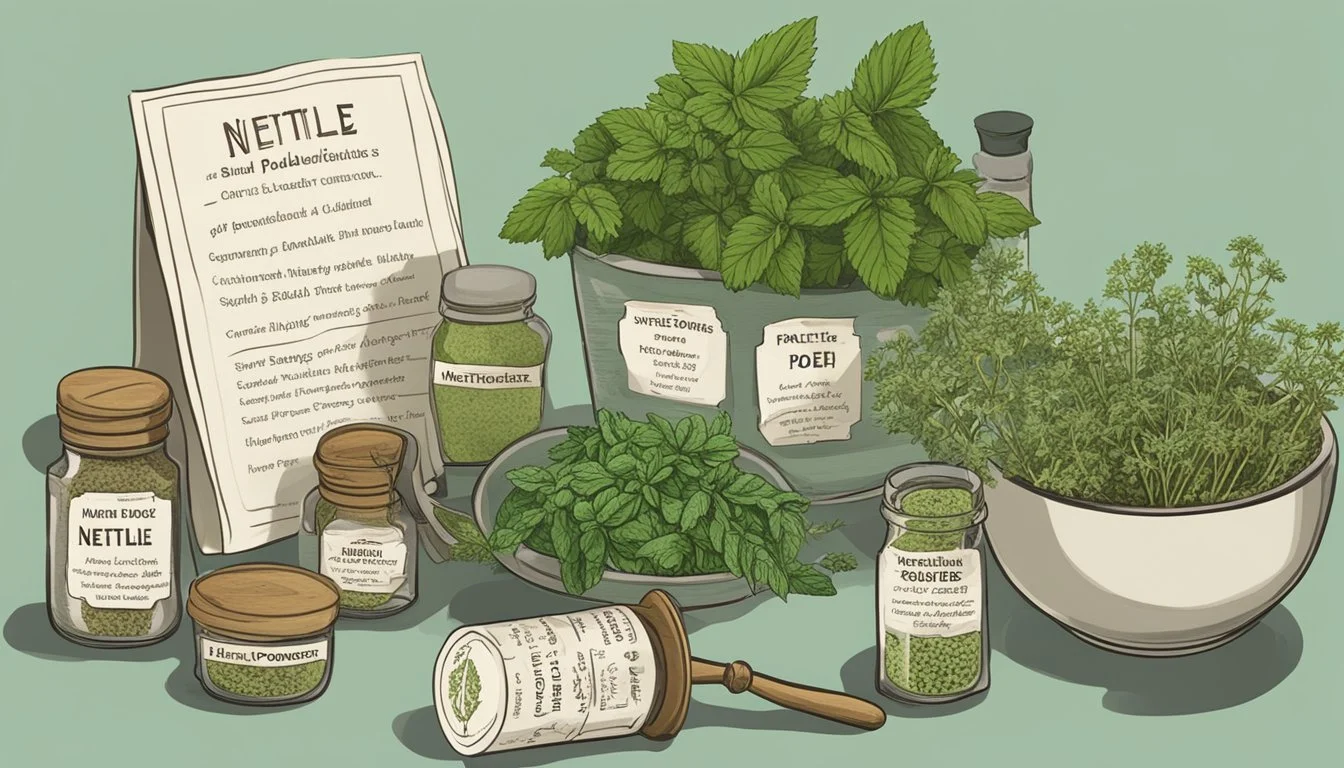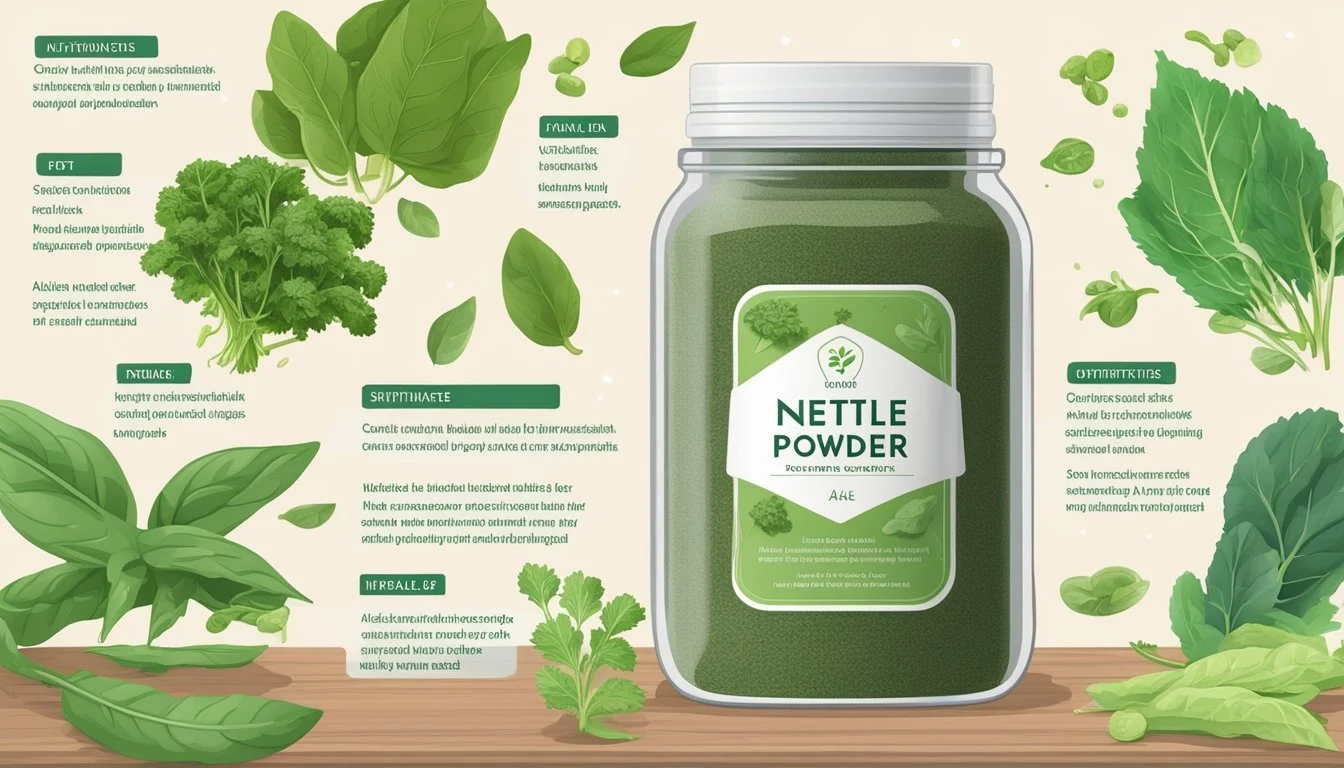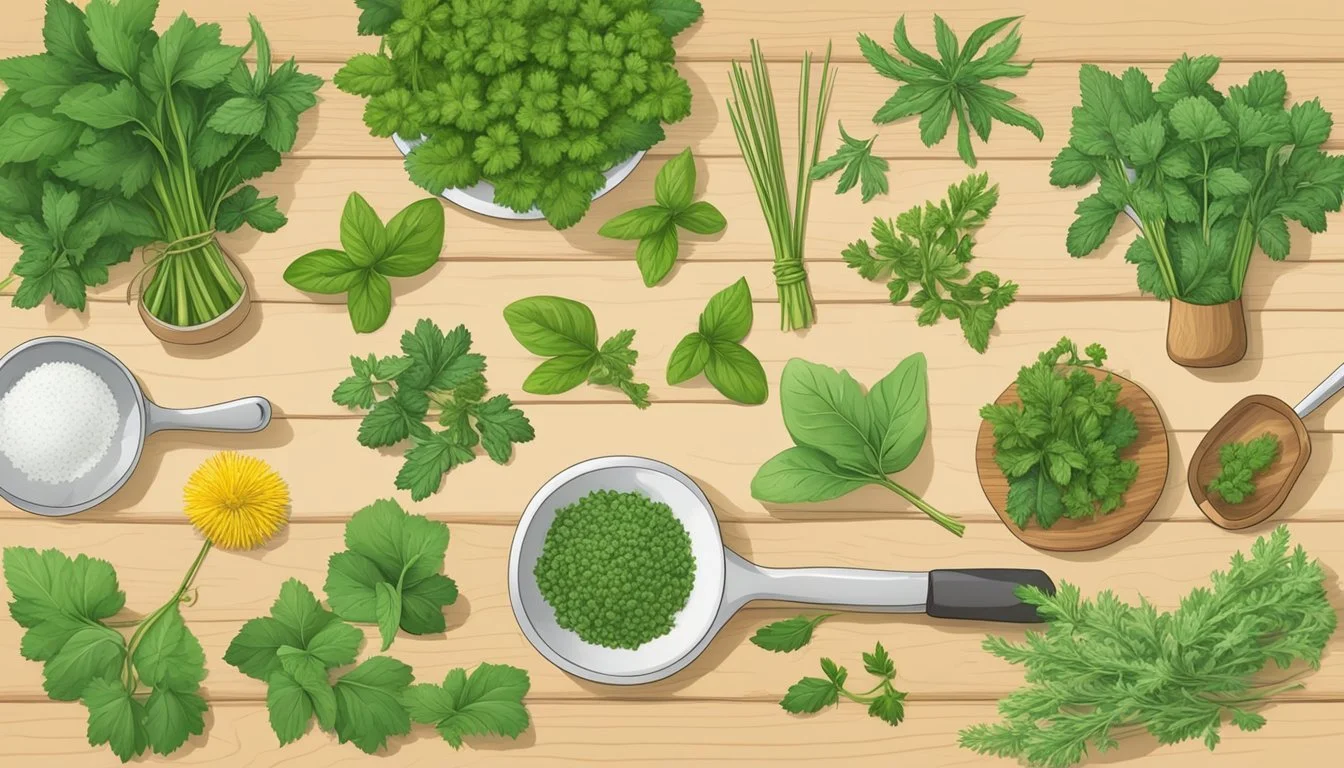Nettle Powder Substitutes
Best Alternatives for Nutrient Boost
For those exploring the health-boosting world of superfoods, nettle powder is often a go-to option due to its rich nutrient profile. Derived from the leaves of the stinging nettle (Urtica dioica), it is renowned for its impressive vitamin, mineral, and antioxidant content, making it a popular supplement in both food and medicine. Yet, there are moments when you might not have nettle powder on hand, or perhaps you're looking for a different flavor or nutritional approach.
Spinach powder stands out as a great nettle powder substitute because it shares a similar nutrient makeup. Packed with vitamins A, C, K, and a good dose of iron, spinach powder can seamlessly integrate into various recipes where nettle powder is used, from smoothies to soups. Spirulina, another superfood, offers a powerhouse of protein and antioxidants and adds a unique twist to your dishes.
Other herbs such as moringa and matcha also provide comparable health benefits and can easily replace nettle powder in your diet. These alternatives ensure you don't miss out on the nutritional boost, maintaining the balance of health and flavor in your culinary creations. Explore these substitutes to keep your meals nutritious and diverse, even when nettle powder isn't available.
Nutritional Profile and Health Benefits
Nettle powder is a powerhouse of nutrients.
Nutritional Profile
Stinging nettle provides vitamins A, C, and K as well as various B vitamins. These vitamins play crucial roles in maintaining good vision, immune function, and blood health. Nettle leaves are high in amino acids, chlorophyll, and a broad array of minerals including calcium, potassium, magnesium, and iron.
For fiber content, nettle powder boasts 9.08% of crude fiber. This helps support digestive health and provides a feeling of fullness. Protein content is notable, with nettle containing 3.2 times and 2.9 times the amount of protein found in wheat and barley flours, respectively.
Health Benefits
Nettle powder is rich in antioxidants. This includes polyphenols and lutein, which help combat oxidative stress and may slow symptoms of aging.
The anti-inflammatory and antihistamine properties in nettle powder are promising. These properties make nettle useful in relieving symptoms of arthritis and managing seasonal allergies. Additionally, nettle may support individuals with benign prostatic hyperplasia (BPH) by promoting urinary health.
Nettle tea, derived from nettle powder, is commonly used to detoxify the body due to its diuretic properties, assisting in removing excess salts and toxins.
For bone health and skin conditions like eczema, nettle’s calcium and vitamin A content contribute significantly. The nutrients in nettle also promote hair vitality, fighting off issues related to aging and contributing to overall wellness.
Culinary Uses
Nettle powder is a versatile ingredient that can enhance various dishes. Utilizing different forms of nettles, such as nettle leaves or dried nettle leaves, also opens up a range of culinary possibilities. Let's explore how to incorporate these options effectively.
Cooking with Nettle Powder
Nettle powder can be used as a nutritious addition to several recipes. It works well as a seasoning, adding a subtle, earthy flavor reminiscent of spinach or kale. You can sprinkle it into soups, stews, or smoothies for an extra health boost. Adding nettle powder to bread dough enhances the flavor and nutritional profile.
In pasta dishes, nettle powder can be mixed into the dough. Pair it with garlic, lemon, and butter for a simple yet flavorful sauce. It's also excellent for making green sauces like pesto, substituting it for basil. The mild taste blends well with other herbs and spices like salt, pepper, and cumin.
Alternative Nettle Forms in Recipes
Besides nettle powder, other forms of nettle can be used in cooking. Fresh or dried nettle leaves can replace spinach in several recipes. Blanching fresh nettles before incorporating them into dishes like omelets or frittatas is important to remove the stinging properties.
Nettle tea or herbal tea made from dried leaves adds a unique flavor to broths and soups. Nettle extracts and tinctures can be added to sauces or dressings for a subtle herbal note. For smoother recipes, nettle capsules can be opened and sprinkled into dishes, ensuring an even distribution of flavor without altering the texture.
Incorporating nettles in various forms into your recipes not only diversifies flavors but also boosts the nutritional content of meals, making them richer in vitamins and minerals.
Substitute Options for Nettle Powder
Nettle powder is often used for its nutritional and herbal benefits, but there are various alternatives you can use whether you are making tea, cooking, or creating your own herb mixes. Below, several options are detailed to fit different needs.
Herbal Alternatives
When it comes to herbal substitutes, parsley, spinach, kale, and basil are viable options. These greens are rich in vitamins and minerals, similar to nettle powder.
Parsley: Has a high content of vitamins A, C, and K, as well as chlorophyll.
Spinach: Known for its iron and folate content.
Kale: Contains high levels of vitamins K, C, and various antioxidants.
Basil: Offers a unique flavor and various health benefits due to its essential oils.
Each of these herbs can be dried and powdered to be used like nettle powder.
Homemade Nettle Powder
Creating homemade nettle powder is simple and ensures you have a fresh product. Begin by collecting fresh nettle leaves. After washing and drying them, you can use a dehydrator set to about 95°F or an oven at its lowest setting.
Dehydrator: Spread leaves on the drying trays and dry for 12-15 hours.
Oven: Place leaves on a baking sheet and dry at a low temperature for several hours, checking frequently.
Once dried, grind the nettles into a fine powder using a food processor or spice grinder.
Substitutes in Cooking
For culinary purposes, alternatives like red pepper powder, garlic, salt, lemon, and vinegar can replace nettle powder in recipes. These substitutes provide unique flavors and nutritional benefits.
Red Pepper Powder: Adds a mild sweetness and vibrant color.
Garlic: Offers a robust, savory flavor that enhances recipes.
Salt: A basic seasoning.
Lemon: Adds a bright, tangy flavor.
Vinegar: Provides acidity and can enhance the flavors of a dish.
These substitutes can be used in various dishes, including soups, sauces, and spice blends, ensuring that your culinary creations remain flavorful and nutritious.
Foraging and Harvesting Nettles
Foraging and harvesting nettles requires proper identification, safety measures, and preservation techniques to ensure maximum utility and safety.
Identifying and Collecting
Nettles, particularly Urtica dioica, are perennial plants commonly found in damp areas like riverbanks or backyards. They have serrated leaves and tiny hairs that sting upon contact.
Early spring is the best time to forage for the young, tender plants. Nettles can be identified by their sharp-toothed leaves and slightly hairy stems.
When collecting, use gloves and a basket to gather the plants. It's advisable to forage in a clean environment, away from polluted areas.
Safety and Preparation
When foraging for stinging nettles, safety is paramount. Wear long sleeves and gloves to avoid contact with the stinging hairs. Once collected, proper preparation is essential to neutralize the sting.
First, wash the leaves thoroughly to remove any dirt or insects. Blanching the leaves in boiling water for a few minutes will destroy the stinging hairs. After blanching, transfer the leaves to ice water to stop the cooking process.
Preservation Methods
Nettles can be preserved using various methods, including drying. They can be air-dried or used in a dehydrator. To dry nettles in a dehydrator, lay them in a single layer on the racks.
Alternatively, nettles can be frozen after blanching. Store them in airtight containers or ziplock bags. This ensures they maintain their nutritional value for later use.
Drying and freezing nettles allows for versatile use in numerous recipes, ensuring a steady supply year-round.
Therapeutic Applications and Dosage
Nettle is valued for its therapeutic applications across various forms, including tea, tinctures, capsules, and pills. It is often used for its anti-inflammatory and antihistamine properties.
Nettle Tea
Nettle tea can help alleviate symptoms of seasonal allergies and hay fever. It is also utilized as a diuretic, aiding in urinary health and fluid retention. The usual dosage is 2-3 cups per day.
Tinctures
Nettle tinctures are a popular herbal medicine for joint pain, arthritis, and reducing symptoms of benign prostatic hyperplasia (BPH). A typical dose is 1-2 ml, taken 2-3 times daily.
Capsules and Pills
For arthritis and detoxifying the liver, nettle is available in capsule or pill form. The recommended dosage for allergic rhinitis is 600 mg per day, split into three doses. For BPH, up to 360 mg of aqueous root extract or 1,200 mg of methanol root extract daily is suggested.
Seasonal Allergies: 600 mg/day
BPH: 360-1,200 mg/day
Joint Pain and Inflammation
Nettle can be an effective treatment for joint pain and inflammation, often prescribed alongside other herbs like chamomile. Its histamine-reducing properties make it beneficial in addressing allergic reactions and inflammation.
Using a blend of these formats, one can harness stinging nettle's benefits effectively. Always consult a healthcare professional before starting any new supplement or therapeutic regime.
Industrial and Alternative Uses
Nettle powder finds applications beyond culinary and nutritional uses.
In the textile industry, nettle fibers have been utilized to produce cloth that is comparable to linen. These fibers are renowned for their strength and durability.
Fiber derived from nettle is also being explored for creating eco-friendly composites. This has the potential to replace synthetic fibers in various industrial applications.
In the paper industry, nettle fibers can be processed to create sustainable paper. This paper offers an environmentally friendly alternative to traditional wood-pulp paper.
Nettle is also employed in producing ropes and threads. These products leverage the natural strength of nettle fibers, providing a robust option for various uses.
Purchasing and Storage Considerations
When buying nettle leaf powder, it is crucial to focus on quality and storage to ensure the best nutrition and shelf life. Proper handling preserves its superfood benefits and maintains its potency as a supplement.
Buying Quality Nettle Powder
When purchasing nettle powder, look for high-quality, organic options. Organic products are free from pesticides and chemicals, which can compromise the powder's nutrition.
Examine the packaging for certification labels, such as USDA Organic or non-GMO.
Fresh and vibrant green color of the powder can indicate high quality. Avoid powders that appear faded or grayish.
Check expiration dates to ensure you are buying a product with a reasonable shelf life. Freshly dried nettle has a richer taste and better nutritional profile.
Reliable brands will provide nutritional information. Look for powders with no added fillers. Consider bulk purchasing from reputable suppliers if you use nettle powder frequently.
Optimal Storage Practices
Storing nettle powder correctly is essential to maintaining its freshness and nutritional value. Keep it in an airtight container to protect it from air exposure, which can degrade its quality.
Store the container in a cool, dark place. Light and heat can diminish the powder's nutrients and affect its taste. A pantry or cupboard away from direct sunlight works best.
Avoid moisture contact. Dryness is crucial; ensure the lid is securely closed after each use.
Consider using a moisture absorber packet inside the container to keep the powder in optimal condition. If purchased in bulk, divide into smaller portions to reduce frequent exposure to air and moisture.
Following these storage practices helps preserve the powder's potent superfood benefits and extends its shelf life.
Appendix: Additional Resources
For those seeking more information on nettle powder substitutes, exploring further readings and engaging with support networks can be invaluable.
Further Reading and Studies
There are numerous resources available for those interested in deepening their knowledge about nettle powder and its substitutes. Several academic journals and online databases offer peer-reviewed studies on the nutritional benefits and uses of nettle and its alternatives.
Books:
"The Herbal Medicine-Maker's Handbook" by James Green
"Backyard Medicine" by Julie Bruton-Seal and Matthew Seal
Research Papers:
Nutritional analyses of nettle and alternative herbs.
Comparative studies on culinary applications.
Websites:
Rural Sprout for practical tips and recipes.
OSU Extension Service for educational articles.
Reading these materials can provide insights and up-to-date information. Partnerships between universities and herbal communities often result in valuable newsletters that discuss ongoing research and breakthroughs in this field.
Support and Community Networks
Engaging with communities can offer practical advice and support, particularly for new users and pregnant individuals seeking safe alternatives. Various online forums and social media groups focus on herbal medicine and nettle substitutes.
Online Forums:
Herbalism and Plant Medicine on Reddit
HerbMentor forums for discussions and queries.
Social Media Groups:
Facebook groups dedicated to herbal remedies.
Instagram accounts of certified herbalists sharing daily tips.
Local Community Networks:
Workshops and classes held at local community centers.
Networking events in local health food stores.
Joining newsletters from these networks can keep individuals informed about the latest trends and research developments. It also helps build a supportive community of like-minded individuals.









